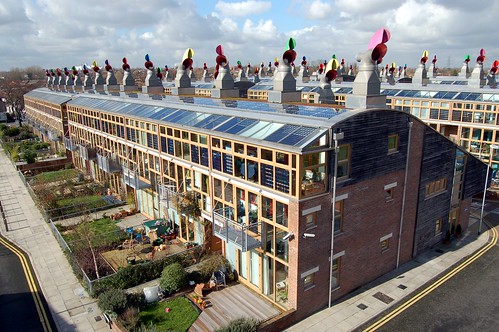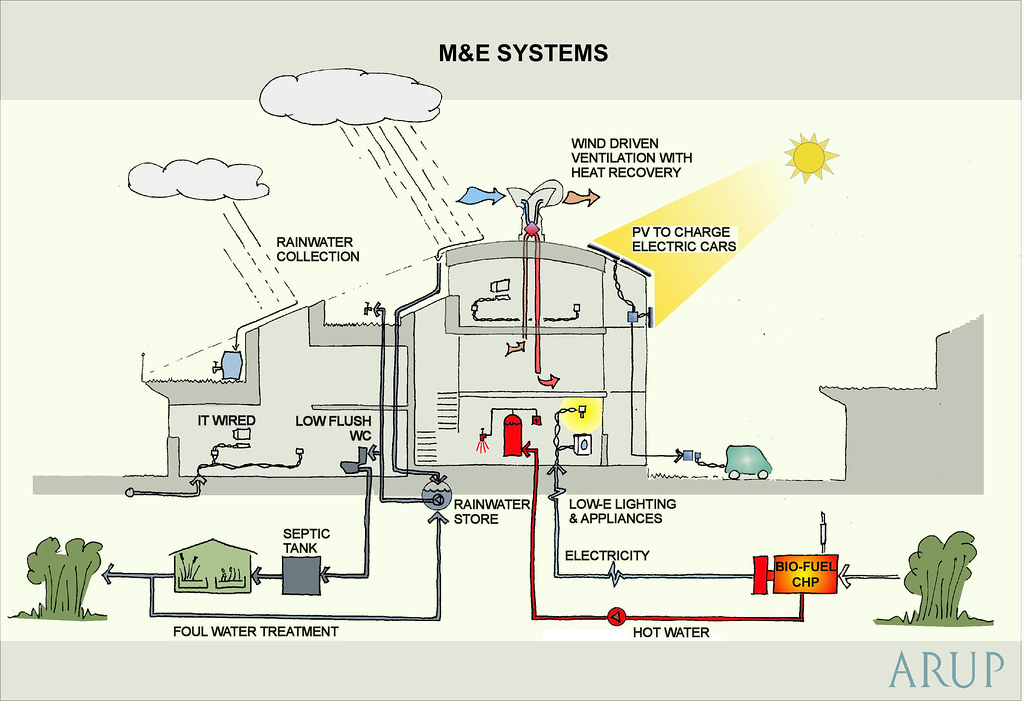Case Study: BedZED
Beddington Zero Energy Development is the UK’s largest mixed use sustainable community. It was designed to create a thriving community in which ordinary people could enjoy a high quality of life, while living within their fair share of the Earth’s resources.
BedZED was initiated by BioRegional and ZEDfactory, and developed by Peabody housing association. It was completed and occupied in 2002. The community comprises 50% housing for sale, 25% shared ownership and 25% social housing for rent.
People move to BedZED with typical lifestyles, and over the years change their behaviour significantly. The holistic design works on three levels:
1.the design solves problems such as heating and water usage;
2. the design and services offered help people make sustainable choices such as walking rather than driving; and
3. the community have created their own facilities and groups to improve quality of life and reduce their environmental impact.
Key Facts
Energy: 81% reduction in energy use for heating, 45% reduction in electricity use (compared to local av.).
Transport: 64% reduction in car mileage 2,318km/year (compared to national av.).
Water: 58% reduction in water use 72 litres/person/day (compared to local av.).
Waste: 60% waste recycled.
Food: 86% of residents buy organic food.
Community: residents know 20 neighbours by name on average.
Community: residents know 20 neighbours by name on average.
Beyond green buildings: creating different ways of living
Improving the energy efficiency of buildings will not deliver the step change in carbon savings we need for true sustainability unless wider societal change takes place, according to Pooran Desai, the co-founder of the organisation that was instrumental in delivering the UK's best known sustainable community Beddington Zero Energy Development (BedZED).
"If society is to successfully achieve meaningful improvements in sustainable living, while reducing greenhouse gas emissions, we need to look beyond what is being built and focus on creating different ways of living. Constructing greener buildings is only part of the solution," argues Desai.Societal change
"Current building regulations deliver reasonable levels of energy efficiency. Therefore, constructing to standards that are well beyond the minimum often does not deliver the environmental benefits we might expect," Desai explains. "As an industry we continue to overestimate the impact of buildings on greenhouse gas emissions and underestimate aspects such as transport, food, waste and behaviour. Although we must improve on them, current building regulations reduce emissions from space heating by almost 70% over a Victorian home. Code level 4 reduces space heating by a further 15% on this baseline, while the marginal benefit of progressing on to code level 6 is only another 5% which in fact amounts to only about 0.5% of greenhouse gas footprint – into the realms of diminishing returns."Buildings in use
"In fact, regulations that focus on the building fabric and resulting emissions might be the best approach rather than wider codes, because the major part of emissions from buildings are not determined by what is built but all the things people do in those buildings – the appliances they choose to fit and how they are used – which arguably are not usefully considered to be part of the remit of building regulations or building standards. These issues are about sustainable living, and cover everything from food to recycling to transport. Behavioural change, or making it easy for people to lead sustainable lifestyles, needs to play a key role in the way a building is occupied and utilised. Finally, the decarbonisation of the energy supply will need to be addressed if greenhouse gas emissions are to be reduced significantly. Ultimately, building codes are only useful to the extent that they support sustainable lifestyles."Different view
"What is needed is a way of looking at a new infrastructure for society that supports a different type of lifestyle. The built environment has an important part to play in achieving sustainable consumption, but focusing purely on the way a building is constructed and used sends misleading messages."Although I am a great supporter of building standards, if not viewed in context, they can misdirect effort. Achieving a BREEAM Excellent rating is a good idea, and should be encouraged, but there is often little point in going the extra mile and gaining BREEAM Outstanding whilst lifestyle issues are not addressed," says Desai.
Ecological footprint
Desai bases his observations on work undertaken at BedZED. Monitoring during the project was showing average electricity consumption 45% lower than in the surrounding area and heating 81% less. By reducing car parking spaces and introducing London's first club car, surveys showed a 65% reduction in private car mileage.At the time, there was a lot of debate on regeneration of the Thames Gateway, with some 200,000 homes forecast to be built. Desai and his team started modelling the environmental savings which could come from implementing the strategies taken at BedZED across the Thames Gateway. They also started using ecological footprinting as a headline indicator of sustainability, including food and waste impacts as well as carbon.
Behaviour change
"By targeting CO2 savings in the planned new homes, by building to high energy efficiency standards, although a 32% reduction in CO2 emissions from the homes was achievable, this translated to an overall reduction in ecological footprint of a shockingly low 4%. It was only when we started reducing transport, waste and food impacts and including behaviour change that we really started to achieve some decent overall ecological footprint savings," says Desai."Yet, the development of sustainable communities remains dominated by green building design. We often hear statements such as 'our buildings contribute nearly half of all our CO2 emissions' followed by the assumption that we will make large environmental gains by constructing buildings to high environmental standards. As an industry, we continue to fail to appreciate from where our environmental impacts arise."
Buildings versus what people do in them
To be effective, Desai believes we need to develop a better understanding of the relative contributions of building fabric versus appliances, food, transport, consumer goods, waste and the other parts which make up our lifestyles. The energy consumption in buildings is partly to do with what we build, and a growing part is what people do in those buildings – the domestic, commercial and industrial appliances which are fitted and how they are used. There is only limited value in considering the energy consumption from these appliances as part of the building. Desai suggests the following analogy: just because the majority of food is consumed in buildings, there is only a limited amount we can do in trying to drive sustainability of the food system through building design or standards. There is not much to be gained from saying buildings are responsible for 95% of impacts associated with food."Although it is essential that we make our buildings greener, particularly by refurbishing older stock, it actually won't reduce our overall environmental impact nearly as much as we might first assume," he says.
GHG not CO2
Desai believes that we can start to unpick the confusion around CO2 emissions figures and how it relates to other measures such as greenhouse gases and ecological footprint. The most quoted government figures for CO2 emissions are what should really be described as "direct CO2 emissions" or "territorial CO2 emissions".These figures represent the CO2 directly emitted by any region or country from burning fossil fuels within its own territorial boundaries. This amounts to around 8.8 tonnes of CO2 a person a year in the UK. However, the territorial CO2 emissions figures don't include international shipping or aviation which add a further 0.7 tonnes a person a year. Adding in the net impact of goods and services we import into the UK gives us a CO2 footprint of 12.08 tonnes.
Even this figure does not include the basket of greenhouse gases (GHG) such as methane and nitrous oxides in addition to CO2. The UK's GHG footprint is 16.34 tonnes of CO2 equivalent a person a year – 86% larger than the original territorial CO2 emissions figure of 8.8 tonnes. If territorial CO2 emissions is used as a guide, the global warming effect of emissions from imported goods, agriculture and international travel is underestimated, and the importance of fossil fuels burned directly, for example, to heat and power our buildings, is overestimated.
Creating sustainable lifestyles
"If we look at ecological footprinting as the headline indicator of sustainability, things look even more different as our CO2 footprint accounts for only 65% of our ecological footprint. A person living in a home built to current building regulations might be releasing 1.5 tonnes of CO2 to provide their heat and power. This equates to 17% of territorial CO2 emissions, 12% CO2 footprint, 9% of GHG footprint but only about 6% of ecological footprint," explains Desai.The necessary step change in environmental savings can only be made when society focuses on creating whole sustainable lifestyles – making it attractive and affordable for people to live without being dependent on cars, where recycling is made easy and where everyone has easy access to local, organic, seasonal produce – for which BioRegional coined the term One Planet Living. This framework is now being applied internationally to create communities focused on sustainable lifestyles not just green buildings, including the recently completed 172 apartment, car-free One Brighton development by Crest Nicholson and BioRegional Quintain.
Desai concludes by saying: "We need energy efficient buildings but we don't need to perform expensive engineering or architectural gymnastics to get decent savings, after which we can focus on other aspects of our lifestyles."

